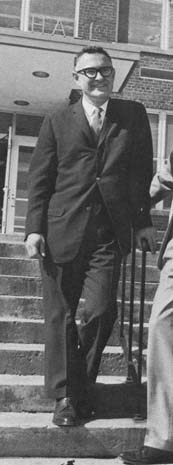PROFESSOR RUSSELL J. JANDOLI
"...a teacher, a mentor, a role model"

Russell Jerome Jandoli was born on August 16, 1918 in Orange, New Jersey. In 1940 he graduated from the University of Notre Dame with a BA in history and a minor in journalism. He received his Master of Science in Journalism at Columbia University in 1941. In 1953 he received a Master of Arts in History from St. Bonaventure University, and, in 1956, his Ph. D. from New York University.
Before he joined the St. Bonaventure staff, he worked as a reporter for The Puerto Rico World Journal, Time Magazine, United Press, Stars & Stripes, the Newark Evening News, and as the editor of publications at the War Department in Washington D.C. Jandoli also instructed in journalism at the University of Puerto Rico.
In January 1947 Jandoli founded the Department of Journalism at St. Bonaventure University. He served as the head of the department for 34 years, the longest tenure of any journalism department chairman in the country, and the longest of any in the School of Arts and Sciences at St. Bonaventure. Jandoli loved the role of director, serving his faculty and students as their liaison and advocate. His whole focus was the teaching of writing.
Jandoli's contributions to the department include donations from The Overseas Press Club, The William Randolph Hearst Foundation, the Frank E. Gannett Newspaper Foundation, and other donors of more than $400,000 over the years, none of them in the form of a personal grant.
Jandoli established with Jim Bishop the Mark Hellinger Award, which is presented annually to a graduate who demonstrates academic excellence and shows genuine promise in the communications arena. He developed the Russell J. Jandoli Alumni Scholarship to a grant exceeding $8,000.
His professional activities while at St. Bonaventure included, chairman of The Journalism Educator, National Supervisor of Judges at the Catholic Press Association. National President of The American Society of Journalism School Administrators. Chairman of the Professional Liaison Committee, ASJSA (American Society of Journalism School Administrators), and Chairman/member of various committee of the ASJSA. Jandoli served as a prime mover in amalgamating publications and other professional efforts of ASJSA and the American Association of Schools and Department of Journalism. Jandoli wrote several papers that were presented before the Association for Education in Journalism, including a study of journalism curriculum in five European countries (Italy, Austria, West Germany, Belgium, and Great Britain).
Jandoli's contributions to student organizations at St. Bonaventure include: Adviser, WSBC/WOFM,1949-1952.; Adviser, The Bona Venture, 1947-1961; Adviser, The Laurel, 1947-1956. Jandoli was the founder and first adviser of Sigma Delta Chi, St. Bonaventure Chapter. Under his direction the chapter was first in the world to initiate women. He also founded Kappa Tau Alpha, St. Bonaventure Chapter, the honorary journalism society.
At St. Bonaventure, Jandoli developed his first journalism curriculum in January 1949. He conducted a survey/study of journalism programs in Catholic colleges and universities in the U.S. He published these in 1960 and 1970. He established a curriculum committee on the Advisory Council to the President on Journalism. Jandoli established the Journalism Newsroom, the Bob Considine Television Laboratory, giving new direction to the curriculum and to instruction. He concentrated on curriculum development in higher education courses at New York University, 1953-1956, and studied the curriculum of five leading universities in Europe on a sabbatical leave in 1970.
Jandoli adjusted the department's curriculum every two to five years to meet the changing needs of the field, always maintaining a strong liberal arts base. A radical program change was initiated in 1978 when the name of the Department was changed from Journalism to Mass Communications. These are its aspects:
1. Intensified writing instruction starting in the first semester of the first year and continuing through to the last semester senior year.
2. Integration with the liberal arts curriculum over the four years. The student begins his/her major in his first semester here with 3 hours of Mass Communications and 12 hours in extra department required courses. This permits him to interrelate from the start, using his/her writing as the integrative instrument. This represents a challenge to the classic arts formula of completing basic arts courses in the first two years before taking on the major.
3. A continued emphasis on the social sciences as the academe of mass communications, with 24 credit hours required. Requirements now permit students to minor in Business and other concentrations, or to select from a broad panoply of contemporary offerings in History and Area Studies, Economics, Psychology, Political Science, and Sociology.
4. Course hours have been re-tailored to content with the understanding that all knowledge is not divided equally into 3-hour offerings. The former 3-hour introductory course has been reduced to 1 credit, with an introductory writing course being offered after the first month. Likewise, a 3-hour offering in Editing, and Graphics has been divided into two 2- hour courses and a 3-hour senior course has been split into three 1-hour courses: research, thesis, internship.